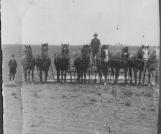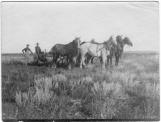2
The 1900's saw the end of an era. The government grazing leases and homestead act changed. The flood of homesteaders crowded the ranchers out. They were forced to diversify and became mixed farmers or moved on. The rail line reached the Avonlea District in 1911.3
A pioneer recalls moving to the prairies.October, 1987
A farm near Avonlea, Saskatchewan, Canada
 Credits:
Credits:Mabel Watson
4
Mabel: I was born March 31, 1894 at Mount Forest, Ontario.Judy: You had how many older brothers and sisters, Grandma?
Mabel: Six older, and two younger, I was the seventh.
Judy: Why did your family leave Ontario to come here?
Mabel: Well, just... to make a home for the family I guess.
Judy: How did you travel from Ontario to Saskatchewan?
Mabel: Well, by train. They unloaded the cars, I think two cars, at Rouleau, with horses, Dad brought some horses, I think some cattle, some wagons and a Democrat, some furniture and ... I don't know... an organ. But they built a sod shack to live in. We were still up at Moose Jaw . I don't know when Mother come, now, whether she come when the men come or like Tommy and Maggie and I stayed up at Harris's for about six weeks, til they got the sod shack built.
Judy: Where was it that they built the sod shack?
Mabel: Down by the homestead house, two miles south of town.
Judy: How big would that house have been?
Mabel: Well, I don't know. I remember two beds sitting along that side, end-to-end and Father had oil-cloth up over to keep the rain off the beds.
Judy: How long did your family live in the sod shack?
Mabel: Well, I'd say we were in the other house in July, but it wasn't plastered.
Donna: So, you would have lived in the sod shack for about 4 months? 3 or 4 months?
Mabel: They did, yes. I maybe was only in it about 6 weeks. I remember sleeping under a wagon box after we came from Moose Jaw.
Judy: The little ones, you and Tommy and Maggie?
Mabel: Yes, well I don't know whether Tommy slept there or on the couch.
Judy: Why did you sleep under the wagon?
Mabel: Well, you see, I said they had two beds; one for the boys and one for Mother and Dad. Along one side, I can remember that. Mother said she was tired one Saturday night and thought she'd have a sleep in the morning. It rained so hard all night one side came in on the sod shack. Some lived in tents.
6
Maple Point and the Ball FamilyIf you take a Saskatchewan road map and draw a straight line from Fort Qu'Appelle to Wood Mountain this, with some adaption for terrain, was the Wood Mountain Trail. A branch led off to Willow Bunch. One of the camping places along the trail was Maple Point which is on a tributary of the Moose Jaw Creek and joins it South West of Rouleau. The oxbows of this prairie creek protected stands of Green Ash, Manitoba Maple and Willow from the prairie fires and so provided shelter and wood as well as water.
Lumber for the first house was said to have come by oxcart from the end of steel at Portage la Prairie. As this land was a CPR section it was not available for homestead use. A sheep rancher was there before 1900; no name is known but there are two stories. After a harsh winter with heavy snowfall and in fear or resultant spring flooding, he moved his flock to higher ground about four miles south to Kincaid's hill and saved his sheep. Another time he was less fortunate when they piled up in a draw on the SW quarter during an unseasonable blizzard and many perished. In confirmation of this story my cousin Lyman Pigeon told of seeing dozens of small white bones exposed by water erosion. In the 1971 Rouleau history book page 77 George Manderson who began homesteading west of town in the Spring of 1902 says that area was a dry dessert. "Previously several settlers had moved in, all were dried out and gone except one man who kept sheep."
My grandparents Gilbert and Alice Ball with their daughters Vera and Ferne moved to Rouleau in the Spring of 1902. They came with his parents Franklin and Sarah Ball, his two brothers Frank and R.L. Mr. and Mrs. Gilmore, their daughters Lettie and Nellie and Newt Harris were on the same train. They came up the Soo Line from Palmyra, Nebraska and brought machinery and livestock including my great grandmother's canaries. They had been up there the fall before to locate land and build a house. In the Spring of 1905 or 1906 Gil, Alice and daughters moved to Maple Point. Gil needed water for his cattle. My father Kenneth was born there in July, followed later by Verna Mae and Vivienne.
My grandfather did custom breaking and plowing with a steam engine and twelve bottom plow. The heavy clay land was difficult to work with horses. He also had a threshing outfit. Among the threshing crew in those early years were Indians and Metis from the Willow Bunch area.
Family anecdotes include these stories. One older native man fought in the Riel Rebellion. The Indians and Metis camped just across the dam in the first creek bend and while the men were away threshing their families trapped muskrats back in the pasture. Aunt Ferne Pigeon remembers learning to skate with a kitchen chair down at the dam and perhaps provoking an altercation with a young native boy. As a result, she went home with a bloody nose. She, thought they were comfortable in camp and recalled that they had warm quilts which the women had made. I remember Grandma's story about a native woman's illness and how men came to the door asking for something. Grandma couldn't understand what they wanted. Later she found that it was only a chicken, which she'd gladly have given. When the woman died, her people packed up and trailed home for the burial. One Fall when the cook left, two women from the camp finished out the season on the cook car. I don't know why that cook left but there is a story of a family disaster equal to the fourteen head of cattle that died of blackleg. The cook - who shall be nameless - left a grocery bill of twelve hundred dollars at the season's end. All the profit gone. And how could it be possible? The account book lists twenty pounds of butter for seven dollars and seventy-five cents for a bag of potatoes.
Years after at the Regina Fair one of the Indian men remembered and spoke to Grandpa and Grandma. Grandpa liked the men and got along well with them and considered them a good crew.
8
The LawFor many years the only law enforcement agency was the North West Mounted Police. They were called "Mounties". They rode a horse in the summer and used a dog sled team in winter. A Mountie didn't come around too often, for 2 reasons. There was very little crime, each ethnic group seemed to solve its own problems and each Mountie covered hundreds and even thousands of miles. They had a reputation of always catching their man and everyone was afraid he would get caught if he committed a crime. Also, in those days there were no cars, no planes, few roads, etc. You could run fast but you couldn't hide. Later, as towns grew and transportation came along, a sherif would be hired.
10
Mabel: But they built a sod shack to live in. We were still up at Moose Jaw . I don't know when Mother come, now, whether she come when the men come or like Tommy and Maggie and I stayed up at Harris's for about six weeks, 'til they got the sod shack built."Judy: Where was it that they built the sod shack?
Mabel: Down by the homestead house, two miles south of town.
Judy: How big would that house have been?
Mabel: Well, I don't know. I remember two beds sitting along that side, end-to-end and Father had oil-cloth up over to keep the rain off the beds.
Judy: How long did your family live in the sod shack?
Mabel: Well, I'd say we were in the other house in July, but it wasn't plastered.
Donna: So, you would have lived in the sod shack for about 4 months?
Mabel: They did, yes. I maybe was only in it about 6 weeks. I remember sleeping under a wagon box after we came from Moose Jaw.
Judy: The little ones, you and Tommy and Maggie?
Mabel: Yes, I don't know whether Tommy slept there or on the couch.
Judy: Why did you sleep under the wagon?
Mabel: Well, you see, I said they had two beds; maybe one for the boys and one for Mother and Dad, along one side, I can remember that. Mother said she was tired one Saturday night and thought she'd have a sleep in the morning. It rained so hard all night one side came in on the sod shack. Some lived in tents.
12
Ron: So, everything wasn't just smooth, when you moved here?Mabel: Do you think so, when you come to noplace? No place to live or...
Ron: When we first started talking, Grandma, that was interesting, because people would leave Mount Forest, Ontario and come here and it's difficult to understand why with all the adversity and the prairie fires and the depression...
Mabel: Well, you take all these people, these Geislers and all them come from the old country here. I mean, there was nothing to start up with outside of Rouleau.
Ron: Did your family not have a farm at Mount Forest?
Mabel: No. My dad was a blacksmith at Mount Forest.
Ron: He was a blacksmith and he came west to get land?
Mabel: Yes. He made sleighs and buggies or shod horses in Ontario. We didn't have no farm.
Judy: Grandma, Grandpa Herb moved here from England?
Mabel: Yes.
Judy: Do you know when the Watson's came to Canada?
Mabel: I think about [190]5.
Judy: And what did his dad do in England?
Mabel: He was a policeman and I think maybe he worked at a butcher's.
Judy: Grandpa had just one sister?
Mabel: Two sisters. One died in the old country of appendicitis. The other was burnt in the States here, down at Nebraska; kids playing with matches or something.



